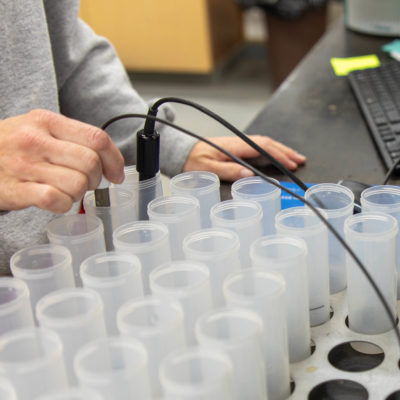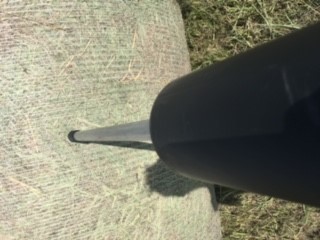The two most common issues that occur when feeding ruminant animals are bloat and acidosis. Bloat is the result of gases not being able to escape from the rumen. It can occur on a forage-based diet due to rapid fermentation of soluble protein and readily available carbohydrates resulting in a frothy entrapment of rumen gases. In the feedlots, bloat is typically a secondary symptom to rapid starch fermentation and acidosis and froth may or may not be present. Acidosis occurs on grain-based diets and is the result of decreased pH in the rumen due to rapid starch fermentation and excess lactic acid presence in the rumen. While bloat is an issue on forage diets, ruminants were adapted to consume a mostly forage diet, but it is not conducive to efficient animal production. Therefore, cattle are often placed on high grain diets for growing and finishing at a high rate of efficiency. Along with increased production on a grain-based diet comes the increased incidence of acidosis and bloat. Here are how 7 feed additives modify rumen metabolism and fermentation process in the rumen to prevent bloat and acidosis.
- Proanthocyanidins also known as condensed tannins, are found in plants such as apples, tree bark, grapes and cranberries. These compounds when present in the rumen at 1-5ppm DM intake, can precipitate soluble protein thereby preventing the accumulation of froth decreasing the incidence of bloat. We are in the day and age where crop improvements are often from manipulation of genetic material to suppress unwanted plant characteristics such as in low lignin varieties of alfalfa and corn. Currently, the consortium for alfalfa improvement is researching the possibility of varieties expressing condensed tannins to prevent legume bloat. This variety may be available in 8 to 10 years if the process proceeds in a similar way to the low lignin varieties.
- Poloxalene is a surfactant which breaks up the soluble protein froth thereby preventing pasture or legume bloat. It can top dress a ration or be offered in a molasses lick.
- Ionophores are a chemical compound that inhibits the growth and activity of gram-positive bacteria in the rumen. Gram-positive bacteria only have one outer cell membrane as opposed to gram negative bacteria that have two and are therefore not susceptible to the effects of ionophores on the bacterial cell. Common gram-positive bacteria in the rumen include cellulolytic bacteria and methanogens. Therefore, the fermentation pathways in the rumen are shifted so that less methane gas is produced and more useful compounds such as volatile fatty acids, which can be utilized by the animal are produced. Ammonia producing bacteria in the rumen also tend to be gram-positive and consequently less protein is degraded to ammonia and by-pass protein increases. Ionophores were originally fed because they change the feed intake habits of the animal to consuming smaller amounts throughout the day which decreases acidosis occurrence. The ultimate result of feeding ionophores on animal production is decreased feed intake, increased rate of gain and thereby improved feed efficiency.
- Buffers include bicarbonate, limestone and magnesium oxide. These compounds increase rumen pH, decreasing acidity. When animals are fed buffers, cellulolytic bacteria populations increase, amylolytic bacterial populations decline and the rate of starch fermentation decreases resulting in less incidence of acidosis.
- Direct Fed Microbials (DFM) are just as they sound, the purposeful feeding of specific microbial species to alter ruminal microbe populations. When feeding DFM the bacterial population is meant to shift from lactic acid producing bacteria to lactic acid using bacteria thereby preventing acidosis. With this feed additive results vary, and they do not always exhibit an impact on acidosis.
- Enzymes that are meant to break down fibers are sometimes fed to increase forage utilization in the rumen.
- Essential Oils are naturally occurring plant secondary metabolites. They are not well understood, and research results are varying. They are currently thought to have the potential to alter rumen fermentation pathways, but the mechanism is not known.
Although the above feed additives can help prevent bloat and acidosis, they can not replace a properly formulated step-up ration and diet or production practices such as backgrounding. One of the best ways to prevent these aliments is to test feed ingredients and formulate a diet plan that moves animals from a low energy forage-based diet to a high energy high-grain diet gradually. This allows those intermediate acid utilizing bacteria with a slower turn over rate to catch up with the diet and reduce the chances of acidosis.





[…] The four groups of microbes present in the rumen, bacteria, protozoa, fungi and archaea, play a major role in how ruminants utilize various feeds especially forages and high starch concentrate. An understanding of microbial roles and interactions in the rumen can help a producer understand the importance of feed testing when formulating a new ration, changing the ruminant’s diet from forage-based to grain-based, and preventing acidosis or bloat. […]